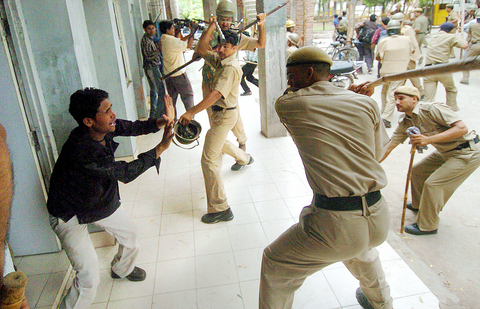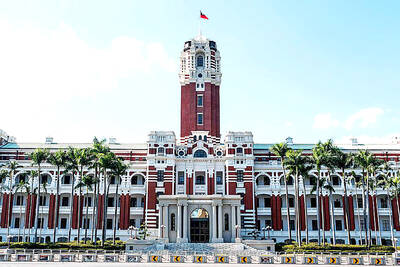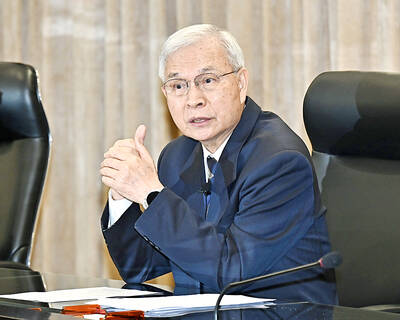Dramatic TV images of Indian police beating workers from the subsidiary of a top Japanese auto firm make it even tougher for the communist-backed coalition to push through labor reforms, analysts say.
Successive Indian governments have talked about making labor laws more flexible to improve competitiveness and attract foreign investment, but have failed to follow through because of the political cost.
Prime Minister Manmohan Singh has been no different. In his first year in office, labor reforms remain on the drawing board. Even privatization has been stalled because of opposition from his communist coalition partners. This opposition seems to be mounting.

PHOTO: AFP
"This issue gives the left something to attack the government and the left is getting serious," said columnist Prem Shanker Jha. "One can forget about labor reforms."
Foreign investors cite India's rigid labour laws, which make it difficult to fire workers during economic downturns, as one of the biggest obstacles to doing business in Asia's third-largest economy.
Although India has one of the fastest-growing major economies in the world, it attracts only a fraction of the investment that pours into regional rival China. While India's economy grew just under 7 percent in the fiscal year ended March, China is achieving growth rates above 9 percent.
The beatings came in the swanky outsourcing boomtown of Gurgaon just outside the capital New Delhi on Monday, after a march by more than 2,000 workers of Honda Motorcycles and Scooters India, a wholly owned subsidiary of Japan's Honda Motor Co, turned violent and protesters attacked police.
In the full glare of Delhi's media, the policemen retaliated brutally, thrashing hundreds of cowering workers with canes after surrounding them. Many lay on the ground, bleeding from head injuries, as the police struck them repeatedly.
There was uproar in parliament the following day, with communist leaders denouncing the police action as "barbaric."
Japanese ambassador Y. Enoki warned the incident was "a disadvantage for India's image as a [foreign investment] destination and also [gave a] negative image of Japanese management."
India sought to calm foreign investor fears as tensions outside the plant remained high yesterday.
"An isolated incident involving a labor dispute should not become a benchmark for judging the investment climate in India," a foreign ministry spokesman.
"The country's democratic institutions and its legal system provide an effective mechanism to deal with such incidents in a transparent manner. The legal interest of foreign investors will be fully safeguarded," he said.
In a bid to avert further violence yesterday, a huge posse of policemen guarded the hospital and access roads as restive workers gathered on the streets. A large security cover was also thrown around the factory compound.
Right-wing commentators blame militant trade unionists for stirring up trouble. Left-wingers say the Honda company were using strong-arm tactics to cower workers with a legitimate grievance.
Either way, the issue has only served to highlight the need for clear and transparent labor laws, which are properly enforced, to keep pace with India's fast-growing economy.
"This incident calls for formulating proper service conditions," said Arun Kumar, professor at the Jawaharlal Nehru University.
"Even the communist parties would support reform in labor policies which provide better working conditions, and foreign investors would also be comfortable when there are clear rules," he said.
Despite its steadily growing economy and undoubted potential, India has struggled to attract foreign investment, managing to bring in around US$4 billion-US$5 billion a year, compared to more than US$50 billion for China.
Investors are put off by India's creaky infrastructure, an overloaded judicial system that can stretch commercial disputes out for a decade and by an often unhelpful, and 20-million-strong bureaucracy.
Communists' suspicion of reforms is another impediment.
"It's not only this incident, but the attitude of the communists to reforms will ultimately impact foreign investor sentiment," said D.H. Pai Panandikar, president of RPG Foundation think tank .
Given the growing gap between rich and poor, some economists like Kumar say the answer lies not in forcing through reforms loaded in favor of employers but in formulating clear rules which reduce confrontation in the workplace.

The CIA has a message for Chinese government officials worried about their place in Chinese President Xi Jinping’s (習近平) government: Come work with us. The agency released two Mandarin-language videos on social media on Thursday inviting disgruntled officials to contact the CIA. The recruitment videos posted on YouTube and X racked up more than 5 million views combined in their first day. The outreach comes as CIA Director John Ratcliffe has vowed to boost the agency’s use of intelligence from human sources and its focus on China, which has recently targeted US officials with its own espionage operations. The videos are “aimed at

STEADFAST FRIEND: The bills encourage increased Taiwan-US engagement and address China’s distortion of UN Resolution 2758 to isolate Taiwan internationally The Presidential Office yesterday thanked the US House of Representatives for unanimously passing two Taiwan-related bills highlighting its solid support for Taiwan’s democracy and global participation, and for deepening bilateral relations. One of the bills, the Taiwan Assurance Implementation Act, requires the US Department of State to periodically review its guidelines for engagement with Taiwan, and report to the US Congress on the guidelines and plans to lift self-imposed limitations on US-Taiwan engagement. The other bill is the Taiwan International Solidarity Act, which clarifies that UN Resolution 2758 does not address the issue of the representation of Taiwan or its people in

US Indo-Pacific Commander Admiral Samuel Paparo on Friday expressed concern over the rate at which China is diversifying its military exercises, the Financial Times (FT) reported on Saturday. “The rates of change on the depth and breadth of their exercises is the one non-linear effect that I’ve seen in the last year that wakes me up at night or keeps me up at night,” Paparo was quoted by FT as saying while attending the annual Sedona Forum at the McCain Institute in Arizona. Paparo also expressed concern over the speed with which China was expanding its military. While the US

SHIFT: Taiwan’s better-than-expected first-quarter GDP and signs of weakness in the US have driven global capital back to emerging markets, the central bank head said The central bank yesterday blamed market speculation for the steep rise in the local currency, and urged exporters and financial institutions to stay calm and stop panic sell-offs to avoid hurting their own profitability. The nation’s top monetary policymaker said that it would step in, if necessary, to maintain order and stability in the foreign exchange market. The remarks came as the NT dollar yesterday closed up NT$0.919 to NT$30.145 against the US dollar in Taipei trading, after rising as high as NT$29.59 in intraday trading. The local currency has surged 5.85 percent against the greenback over the past two sessions, central